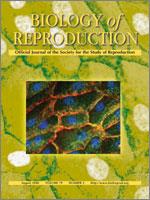The present study demonstrates the expression of adrenomedullin (ADM) in the reproductive system of the female rat and its effect on the secretion of estradiol and progesterone. Ovarian ADM and Adm mRNA levels were decreased at estrus, whereas oviductal Adm mRNA levels were low at proestrus. Both tissues were shown to coexpress mRNAs encoding the calcitonin receptor-like receptor and receptor activity-modifying protein 1 (Ramp1), Ramp2, and Ramp3. Gel filtration chromatography of ovarian extracts showed two peaks, with the predominant one eluting at the position of authentic rat ADM (1–50) at estrus and at the position of ADM precursor at diestrus. Positive ADM immunostaining was localized in the granulosa and theca cells of the follicle and corpora lutea of the ovary. Adrenomedullin inhibited FSH-induced estradiol secretion in 2-day-old follicles and also suppressed eCG-stimulated progesterone release in corpora lutea. The inhibitory effect of ADM on the follicles and the corpora lutea was abolished by calcitonin gene-related peptide (8–37) and ADM (22–52), respectively. The presence of ADM and the gene expression of ADM and its receptor components in the female reproductive system suggest a paracrine effect of ADM on ovarian steroidogenesis.
How to translate text using browser tools
1 August 2008
Coexpression of Adrenomedullin and Its Receptors in the Reproductive System of the Rat: Effects on Steroid Secretion in Rat Ovary
Yuk-Yin Li,
Lei Li,
Isabel Shui-Shan Hwang,
Fai Tang,
Wai-Sum O
ACCESS THE FULL ARTICLE

Biology of Reproduction
Vol. 79 • No. 2
August 2008
Vol. 79 • No. 2
August 2008
estradiol
follicle-stimulating hormone
human chorionic gonadotropin
ovary
progesterone




